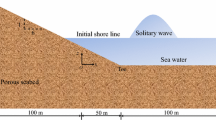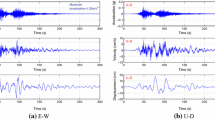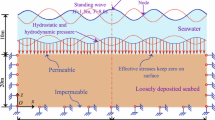Abstract
In this study, based on the dynamic Biot’s theory “u-p” approximation, a 3D finite element method (FEM) numerical soil model is developed, in which the Generalized Newmark-method is adopted to determine the time integration. The developed 3D FEM soil model is a part of the coupled model PORO-WSSI 3D for 3D wave-seabed-marine structures interaction problem, and is validated by the analytical solution proposed by Wang (2000) for a laterally infinite seabed loaded by a uniform force. By adopting the developed 3D soil model, the consolidation of seabed under a caisson breakwater and hydrostatic pressure is investigated. The numerical results show that the caisson breakwater built on seabed has very significant effect on the stresses/displacements fields in the seabed foundation after the transient deformation and primary consolidation are completed. The parametric study indicates that the Young’s modulus E of seabed is the most important parameter to affect the settlement of breakwater, and the displacement fields in seabed foundation. Taking the consolidation status as the initial condition, the interaction between ocean wave, caisson breakwater and seabed foundation is briefly investigated. The 3D ocean wave is determined by solving the Navier-Stokes equations with finite volume method (FVM). The numerical results indicate that there is intensive interaction between ocean wave, caisson breakwater and seabed foundation; and the breakwater indeed can effectively block the wave energy propagating to the coastline.
Similar content being viewed by others
References
Chung S G, Kim S K, Kang Y J, Im J C et al. Failure of a breakwater founded on a thick normally consolidated clay layer. Geotechnique, 2006, 56(3): 393–409
Franco L. Vertical breakwaters: the Italian experience. Coast Eng, 1994, 22(1–2): 31–55
Lundgren H, Lindhardt J H C, Romold C J. Stability of breakwaters on porous foundation. In: Proceeding of 12th International Conference on Soil Mechanics and Foundation Engineering, Rio de Janeiro, 1989. 451–454
Yamamoto T, Koning H, Sellmeijer H, et al. On the response of a poro-elastic bed to water waves. J Fluid Mech, 1978, 87(1): 193–206
Hsu J R, Jeng D S. Wave-induced soil response in an unsaturated anisotropic seabed of finite thickness. Int J Num Anal Meth Geomech, 1994, 18(11): 785–807
Ulker M B C, Rahman M S, Jeng D-S. Wave-induced response of seabed: Various formulations and their applicability. Appl Ocean Res, 2009, 31(1): 12–24
Jeng D S, Cha D H, Lin Y S et al. Wave-induced pore pressure around a composite breakwater. Ocean Eng, 2001, 28: 1413–1435
Mizutani N, Mostarfa A, Iwata K. Nonlinear regular wave, submerged breakwater and seabed dynamic interaction. Coast Eng, 1998, 33: 177–202
Mostafa A, Mizutani N, Iwata K. Nonlinear wave, composite breakwater, and seabed dynamic interaction. J Waterw, Port, Coast, Ocean Eng, 1999, 25(2): 88–97
Ye J H, Jeng D-S, Liu P L-F, et al. An integrated model for the wave induced seabed response around marine structures: Model, verifications and applications. Coast Eng, submitted
Wang J G, Karim M, Lin P. Analysis of seabed instability using element free Galerkin method. Ocean Eng, 2007, 34(2): 247–260
Luan M T, Qu P, Yang Q. Wave-induced dynamic response of seabed around submarine pipeline. Chin J Rock Mech Eng, 2008, 27(4): 789–795
Terzaghi K. Erdbaumechanik auf Bodenphysikalischer Grundlage. Vienna: F. Duticke, 1925
Biot M A. General theory of three dimensional consolidation. J Appl Phys, 1941, 12(2):155–164
Biot M A. Theory of propagation of elastic waves in an unsaturated porous solid, part I: Low frequency range. J Acoust Soc, Am, 1956, 28: 168–177
Sloan S W, Abbo A J. Biot consolidation analysis with automatic time stepping and error control part 1: Theory and implementation. Int J Num Anal Meth Geomech, 1999, 23(6): 467–492
Cavalcanti M C, Telles J C F. Biot’s consolidation theory-application of bem with time independent fundamental solutions for poro-elastic saturated media. Eng Anal Bound Elem, 2003, 27(2): 145–157
Korsawe J, Starke G, Wang W, et al. Finite element analysis of poroelastic consolidation in porous media: Standard and mixed approaches. Computer Meth Appl Mech Eng, 2006, 195(9–12): 1096–1115
Wang J G, Xie H, Leung C. A local boundary integral-based meshless method for Biot’s consolidation problem. Eng Anal Bound Elem, 2009, 33(1): 35–42
Ferronato M, Castelletto N, Gambolati G. A fully coupled 3-d mixed finite element model of Biot consolidation. J Comput Phys, 2010, 229(12): 4813–4830
Hua L. Stable element-free galerkin solution procedures for the coupled soilcpore fluid problem. Int J Num Meth Eng, 2011, 86(8): 1000–1026
Zienkiewicz O C, Chang C T, Bettess P. Drained, undrained, consolidating and dynamic behaviour assumptions in soils. Geotechnique, 1980, 30(4): 385–395
Ou Jianhua. Three-dimensional numerical modeling of interaction between soil and pore fluid. Doctoral Dissertation. Birmingham: University of Birmingham, 2009
Ye J H, Jeng D-S. Effects of bottom shear stresses on the wave-induced dynamic response in a porous seabed: PORO-WSSI (shear) model. Acta Mech Sin, 2012, 27(6): 898–910
Wang H F. Theory of Linear Poroelasticity with Application to Geomechanics and Hydrogeology. Princeton: Princeton University Press, 2000
Chung S G, Kim S K, Kang Y J, et al. Failure of a breakwate founded on a thick normally consolidated clay layer. Geotechnique, 2006, 56(3): 393–409
Zhang F G, Ge Z J. A study on some causes of rubble mound breakwater failure. China Ocean Eng, 1996, 10(4): 473–481
Zen K, Umehara Y, Finn W D L. A case study of the wave-induced liquefactionof sand layers under damaged breakwater. In: Proceeding 3rd Canadian Conference on Marine Geotechnical Engineering, St. John’s, Newfoundland, 1985. 505–520
Wang J G, Zhang B, Nogami T. Wave-induced seabed response analysis by radial point interpolation meshless method. Ocean Eng, 2004, 31(1): 21–42
Ulker M B C, Rahman M S, Guddati M N. Wave-induced dynamic response and instability of seabed around caisson breakwater. Ocean Eng, 2009, 37(17–18): 1522–1545
Tsai C P, Lee T L. Standing wave induced pore pressure in a porous seabed. Ocean Eng, 1995, 22(6): 505–517
Lin Z P, Liu P L-F. Internal wave-maker for navier-stokes equations models. J Waterway, Port, Coastal, Ocean Eng, 1999, 99(4): 207–215
Okusa S. Wave-induced stress in unsaturated submarine sediments Geotechnique, 1985, 35(4): 517–532
Young Y L, White J A, Xiao H et al. Liquefaction potential of coastal slopes induced by solitary waves. Acta Geotech, 2009, 4(1): 17–34
Xiao H, Young Y L, Prevost J H. Parametric study of breaking solitary wave induced liquefaction of coastal sandy slopes. Ocean Eng, 2010, 37(17–18): 1546–1553
Zhang X Y, Lee F H, Leung C F. Response of caisson breakwater subjected to repeated impulsive loading. Geotechnique, 2009, 59(1): 3–16
Author information
Authors and Affiliations
Corresponding author
Rights and permissions
About this article
Cite this article
Ye, J., Jeng, D. & Chan, A.H.C. Consolidation and dynamics of 3D unsaturated porous seabed under rigid caisson breakwater loaded by hydrostatic pressure and wave. Sci. China Technol. Sci. 55, 2362–2376 (2012). https://doi.org/10.1007/s11431-012-4888-4
Received:
Accepted:
Published:
Issue Date:
DOI: https://doi.org/10.1007/s11431-012-4888-4




